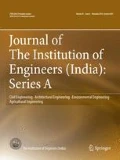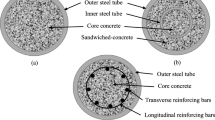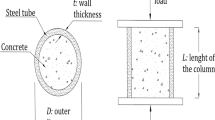Abstract
The concrete filled steel tubular (CFST) columns are highly regarded in recent years as an interesting option in the construction field by designers and structural engineers, due to their exquisite structural performance, with enhanced load bearing capacity and energy absorption capacity. This study presents a new approach to simulate the capacity of circular CFST columns under axial loading condition, using a large database of experimental results by applying artificial neural network (ANN). A well trained network is established and is used to simulate the axial capacity of CFST columns. The validation and testing of the ANN is carried out. The current study is focused on proposing a simplified equation that can predict the ultimate strength of the axially loaded columns with high level of accuracy. The predicted results are compared with five existing analytical models which estimate the strength of the CFST column. The ANN-based equation has good prediction with experimental data, when compared with the analytical models.













Similar content being viewed by others
Abbreviations
- Ac :
-
Area of the concrete section
- Ay :
-
Area of the steel section
- D:
-
Diameter of circular cross-section
- t:
-
The thickness of the steel tube
- fy :
-
Yield strength of the steel tube
- Ea :
-
Modulus of elasticity of steel
- fck :
-
The characteristic concrete strength
- Ec :
-
The secant modulus of elasticity of concrete
- L:
-
The length of the column
- fconf :
-
Confined compressive strength of concrete
- ηc :
-
The coefficient of confinement of concrete
- fcp :
-
Unconfined compressive strength of concrete
- ϒc :
-
Strength reduction factor introduced to the scale effect into consideration
- \({\text{f}}_{\text{c}}^{{\prime }}\) :
-
The unconfined cylinder compressive strength of concrete
- Dc :
-
Diameter of the core
References
ACI (American Concrete Institute), Committee ACI 318-1995: Building Code Requirements for Structural Concrete (Farmington Hills, Michigan, 1995)
M. Ahmadi, H. Naderpour, A. Kheyroddin, Utilization of artificial neural networks to prediction of the capacity of CCFT short columns subject to short term axial load. Arch. Civ. Mech. Eng. 14, 510–517 (2014)
AS (Australian Standards), AS 4100: Steel Structures (Standards Australia, Sydney, 1998)
A.T.A. Dantas, M.B. Leite, K. de Jesus Nagahama, Prediction of compressive strength of concrete containing construction and demolition waste using artificial neural networks. Constr. Build. Mater. 38, 717–722 (2013)
B. Dutta, S.K. Bhattacharyya, An experimental study on the behaviour of concrete filled light gauge steel tubular columns. Indian Concrete J. 10, 477–480 (1995)
EC (Eurocode), EC-4: Design of Composite Steel and Concrete Structures—General Rules and Rules for Buildings (British Standard Institutions, London, 2004)
E. Ellobody, B. Young, Behaviour of normal and high strength concrete-filled compact steel tube circular stub columns. J. Constr. Steel Res. 62, 706–715 (2006)
A. Elremaily, A. Azizinamini, Behavior and strength of circular concrete-filled tube columns. J. Constr. Steel Res. 58, 1567–1591 (2002)
A. Fam, F.S. Qie, S. Rizkalia, Concrete filled tubes subjected to axial compression and under cyclic loads. J. Struct. Eng. 130, 631–639 (2004)
G.D. Garson, Interpreting neural-network connection weights. AI Expert 6, 47–51 (1991)
G. Giakoumelis, D. Lam, Axial capacity of circular concrete-filled tube columns. J. Constr. Steel Res. 60, 1049–1068 (2004)
C.D. Goode, ASCCS Database of Concrete-Filled Steel Tube Columns. http://web.ukonline.co.uk/asccs2/. Accessed 12 Feb 2013
P.K. Gupta, S.M. Sarda, M.S. Kumar, Experimental and computational study of concrete filled steel tubular columns under axial loads. J. Constr. Steel Res. 63, 182–193 (2007)
L.-H. Han, J.-S. Huo, Y.-C. Wang, Behavior of steel beam to concrete-filled steel tubular column connections after exposure to fire. J. Struct. Eng. 10, 800–814 (2007)
L.-H. Han, W. Li, R. Bjorhovde, Developments and advanced applications of concrete-filled steel tubular (CFST) structures: members. J. Constr. Steel Res. 100, 211–228 (2014)
G.D. Hatzigeorgiou, Numerical model for the behavior and capacity of circular CFT columns. Part II: verification and extension. Eng. Struct. 30, 1579–1589 (2008)
H.J. Helena, M. Neelamegam, G.M. Samuel Knight, Investigation on the behaviour of concrete filled columns. J. Struct. Eng. 34, 257–265 (2007)
S.K. Jain, P.C. Nayak, K.P. Sudheer, Models for estimating evapotranspiration using artificial neural networks, and their physical interpretation. Hydrol. Process. 22, 2225–2234 (2008)
S. Lai, M. Serra, Concrete strength prediction by means of neural network. Constr. Build. Mater. 11, 93–98 (1997)
S.-H. Lee, B. Uy, S.-H. Kim, Y.-H. Choi, S.-M. Choi, Behavior high strength of circular concrete-filled steel tubular (CFST) Columns under eccentric loading. J. Constr. Steel Res. 67, 1–13 (2011)
C.K. Leung, M.Y. Ng, H.C. Luk, Empirical approach for determining ultimate FRP strain in FRP-strengthened concrete beams. J. Compos. Constr. 10, 125–138 (2006)
Z.H. Lu, Y.G. Zhao, Mechanical behavior and ultimate strength of circular CFT columns subjected to axial compression loads, in 14th World Conference on Earthquake Engineering, Beijing (2008)
J.B. Mander, M.J.N. Priestley, R. Park, Theoretical stress–strain model for con fined concrete. J. Struct. Eng. 114, 1804–1826 (1988)
E.K. Mohanraj, S. Kandasamy, Experimental behaviour of axially loaded hollow steel columns in-filled with concrete. IE(I) J.-CV 88, 23–29 (2008)
E.K. Mohanraj, S. Kandasamy, N. Rajkumar, Study on concrete using waste materials by partial replacement of aggregates to reduce global warming gases. Indian J. Sci. Technol. 3, 159–163 (2011)
S. Morino, K. Tsuda, Design and construction of concrete-filled steel tube column system in Japan. Earthq. Eng. Eng. Seismol. 4, 52–72 (2003)
A. Oztas, M. Pala, E. Ozbay, E. Kanca, N. Caglar, M. Asghar Bhatti, Predicting the compressive strength and slump of high strength concrete using neural network. Constr. Build. Mater. 20, 769–775 (2006)
M. Pala, E. Ozbay, A. Oztas, M.I. Yuce, Appraisal of long-term effects of fly ash and silica fume on compressive strength of concrete by neural networks. Constr. Build. Mater. 21, 384–394 (2007)
V.P. Patil, Finite element approach to study the elastic instability of concrete filled steel tubular column under axial loads. Int. J. Emerg. Technol. Adv. Eng. 2, 276–284 (2012)
J.M. Portoles, E. Serra, M.L. Romero, Influence of ultra-high strength infill in slender concrete-filled steel tubular columns. J. Constr. Steel Res. 86, 107–114 (2013)
X. Qu, Z. Chen, G. Sun, Experimental study of rectangular CFST columns subjected to eccentric loading. Thin-Walled Struct. 64, 83–93 (2013)
K. Sakino, H. Nakahara, S. Morin, I. Nishiyama, Behavior of centrally loaded concrete-filled steel-tube short columns. J. Struct. Eng. 130, 180–188 (2004)
M. Saridemir, Prediction of compressive strength of concretes containing metakaolin and silica fume by artificial neural networks. Adv. Eng. Softw. 40, 350–355 (2009)
J. Schmidhuber, Deep learning in neural networks: an overview. Neural Netw. 61, 85–117 (2015)
S.P. Schneider, Axially loaded concrete-filled steel tubes. J. Struct. Eng. 124, 1125–1138 (1998)
H.K. Sen (1969) Triaxial Effects in Concrete-Filled Tubular Steel Columns. Ph.D. thesis, University of London, England (1969)
N.E. Shanmugam, B. Lakshmi, State of the art report on Steel Concrete Composite Columns. J. Constr. Steel Res. 57, 1041–1080 (2001)
I.B. Topcu, M. Saridemir, Prediction of properties of waste AAC aggregate concrete using artificial neural network. Comput. Mater. Sci. 41, 117–125 (2007)
SNNS (Stuttgart Neural Network Simulator) software simulator for neural networks. http://www.ra.cs.uni-tuebingen.de/SNNS/. Accessed 2 May 2015
X.M. Yu, B.C. Chen, A statistical method for predicting the axial load capacity of concrete filled steel tubular columns. Int. J. Civ. Environ. Eng. 20, 20–39 (2011)
Acknowledgements
Technical supports for this study provided by the Department of Civil Engineering, National Institute of Technology, Tiruchirappalli, Tamil Nadu, India, is gratefully acknowledged. The authors thank Government of India, Ministry of Human Resource Development—Department of Higher Education, for the Ph.D. scholarship given to the research scholar to carry out the research work.
Author information
Authors and Affiliations
Corresponding author
Rights and permissions
About this article
Cite this article
Jayalekshmi, S., Jegadesh, J.S.S. & Goel, A. Empirical Approach for Determining Axial Strength of Circular Concrete Filled Steel Tubular Columns. J. Inst. Eng. India Ser. A 99, 257–268 (2018). https://doi.org/10.1007/s40030-018-0291-x
Received:
Accepted:
Published:
Issue Date:
DOI: https://doi.org/10.1007/s40030-018-0291-x




